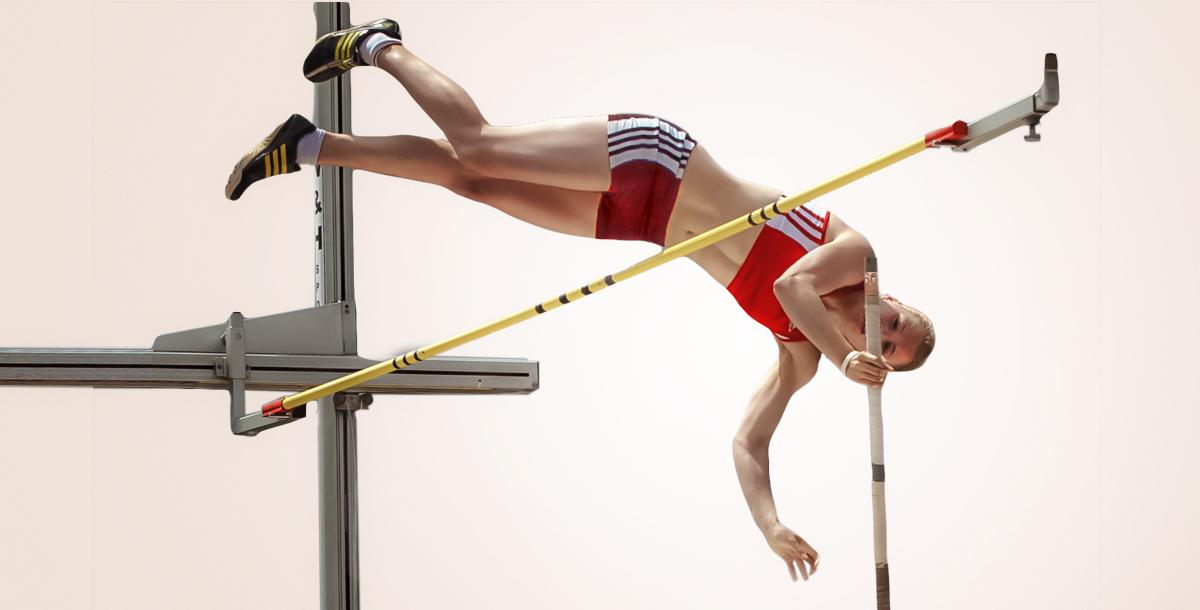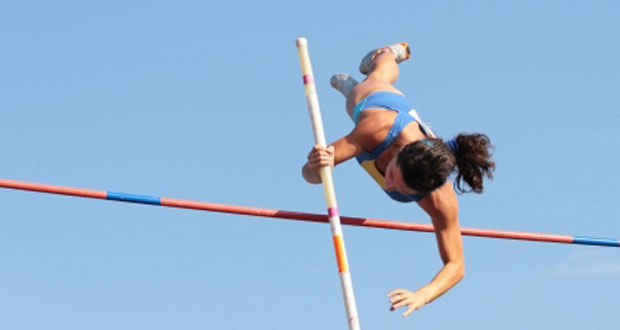Introduction: Embracing the Art of Pole Vaulting
Pole vaulting is an exhilarating and challenging track and field event that combines the grace of gymnastics with the power of running. As a beginner, mastering the correct techniques is crucial to ensure progress, enjoyment, and, most importantly, safety in the sport. This comprehensive guide outlines the essential steps for novice vaulters, providing a solid foundation for their pole vaulting journey.

Understanding the Equipment: Selecting the Right Pole
Pole vaulting requires a carefully selected piece of equipment to ensure safety and success. As a beginner, understanding the importance of choosing the correct pole for your height, weight, and skill level is essential. The right pole will provide the necessary support and flexibility for a successful vault, while the wrong one can lead to injuries or poor performance.
Fiberglass and carbon fiber poles are the two primary materials used in modern pole vaulting. Fiberglass poles are more common for beginners due to their affordability and durability. They offer a good balance of strength and flexibility, making them suitable for various skill levels. Carbon fiber poles, on the other hand, are lighter and stiffer than fiberglass poles, providing more energy return for advanced vaulters. However, they are typically more expensive and may not be ideal for beginners.
Three key factors to consider when selecting a pole are grip, stiffness, and length. The grip is the top part of the pole where the vaulter holds on during the approach and plant. Ensuring a comfortable and secure grip is crucial for maintaining control throughout the vault. Stiffness, measured in pounds per inch (PPI), determines how much the pole will bend during the plant and takeoff. A beginner should start with a softer, more flexible pole and gradually progress to stiffer poles as their strength and skill level improve. Lastly, the length of the pole affects the vaulter’s takeoff position and the amount of energy transferred during the vault. A general rule of thumb is to choose a pole that allows the vaulter’s arms to be fully extended when holding the grip, with their feet slightly behind the pole’s balance point.

Setting Up the Approach: The Foundation of a Successful Vault
The approach is a critical aspect of pole vaulting, as it sets the stage for the rest of the vault. A proper approach technique involves a consistent and balanced stride pattern, ensuring a smooth transition into the plant and takeoff. Beginners should focus on mastering the approach before moving on to more advanced techniques.
A typical approach consists of 12-15 steps, depending on the vaulter’s height and stride length. The first few steps should be slow and controlled, allowing the vaulter to build momentum and establish a rhythm. As the vaulter approaches the takeoff point, their steps should become quicker and more powerful. The last two steps, known as the penultimate and takeoff steps, are crucial for generating the necessary speed and height for a successful vault.
The takeoff point, where the vaulter plants the pole and leaves the ground, should be approximately 1-2 meters (3-6 feet) beyond the box. Proper body positioning is essential during the approach and takeoff. Vaulters should maintain an upright posture, with their hips and shoulders aligned over their feet. This alignment allows for optimal power transfer and ensures a stable and balanced takeoff.
Consistency is key when setting up the approach. Vaulters should practice their approach technique regularly, focusing on maintaining a consistent stride pattern and body positioning. This consistency will help build muscle memory and improve overall performance in the vault. Additionally, incorporating drills and exercises that target lower body strength, power, and balance can further enhance a vaulter’s approach technique.

Planting the Pole: The Make-or-Break Moment
Planting the pole is a critical moment in the pole vault, as it directly impacts the vaulter’s ability to generate height and maintain balance throughout the vault. A proper pole plant involves correct hand position, pole angle, and body alignment. Beginners should focus on mastering these elements to ensure a successful vault.
The hand position during the pole plant should be just beyond the shoulder, with the top hand holding the pole at approximately eye level. This hand position allows for optimal leverage and control during the plant and takeoff. Vaulters should avoid holding the pole too high or too low, as this can negatively impact their balance and ability to generate height.
The pole angle during the plant should be approximately 70-80 degrees relative to the ground. A proper pole angle ensures that the vaulter’s momentum is directed upward, rather than being absorbed by the pole. Vaulters should practice planting the pole at the correct angle to build muscle memory and improve overall performance.
Body alignment during the plant is also crucial for a successful vault. Vaulters should maintain an upright posture, with their hips and shoulders aligned over their feet. This alignment allows for optimal power transfer and ensures a stable and balanced takeoff. Common mistakes during the plant include leaning too far forward or backward, which can result in a loss of balance and a reduced ability to generate height.
To avoid these common mistakes, beginners should practice the pole plant technique regularly, focusing on maintaining proper hand position, pole angle, and body alignment. Incorporating drills and exercises that target upper body strength, core stability, and balance can further enhance a vaulter’s planting technique. Additionally, working with a coach or experienced vaulter can provide valuable feedback and guidance for improving overall performance in the pole vault.

The Drive Phase: Propelling Upward Momentum
The drive phase is a critical moment in the pole vault, as it directly impacts the vaulter’s ability to generate height and maintain balance throughout the vault. A proper drive phase involves quick and powerful leg drive, upper body strength, and proper body positioning. Beginners should focus on mastering these elements to ensure a successful vault.
During the drive phase, vaulters should focus on generating as much upward momentum as possible. This can be achieved through quick and powerful leg drive, which involves extending the legs and driving the knees upward. Vaulters should also engage their core and upper body muscles to provide additional stability and power during the drive phase.
Proper body positioning is also crucial during the drive phase. Vaulters should maintain an upright posture, with their hips and shoulders aligned over their feet. This alignment allows for optimal power transfer and ensures a stable and balanced takeoff. Common mistakes during the drive phase include leaning too far forward or backward, which can result in a loss of balance and a reduced ability to generate height.
To improve the drive phase, beginners should incorporate exercises that target lower body strength, core stability, and power. Squats, lunges, and plyometric jumps can all help to improve leg drive and overall power during the drive phase. Additionally, practicing the drive phase with a focus on proper body positioning and alignment can help to build muscle memory and improve overall performance in the pole vault.
Incorporating drills and exercises that target the upper body and core muscles can also enhance a vaulter’s drive phase. Medicine ball throws, push-ups, and plank variations can all help to improve upper body strength and core stability, which are crucial for maintaining balance and generating height during the drive phase.
In summary, the drive phase is a critical moment in the pole vault, as it directly impacts the vaulter’s ability to generate height and maintain balance throughout the vault. By focusing on quick and powerful leg drive, proper body positioning, and incorporating exercises that target lower body strength, core stability, and power, beginners can improve their drive phase and overall performance in the pole vault.

The Turn: Transitioning from Vertical to Horizontal Motion
The turn phase is a critical moment in the pole vault, as it marks the transition from vertical to horizontal motion. A proper turn phase involves correct timing, body positioning, and leg action. Beginners should focus on mastering these elements to ensure a smooth and successful transition during the vault.
During the turn phase, vaulters must time their rotation correctly to ensure a smooth transition from vertical to horizontal motion. This can be achieved by initiating the turn at the correct moment, which is typically just after the top of the vault. Vaulters should also focus on maintaining speed and balance during the turn, as this will help to ensure a successful transition and a stable landing.
Proper body positioning is also crucial during the turn phase. Vaulters should maintain an upright posture, with their hips and shoulders aligned over their feet. This alignment allows for optimal balance and control during the turn. Common mistakes during the turn phase include leaning too far forward or backward, which can result in a loss of balance and a reduced ability to maintain speed and control.
Leg action is another important aspect of the turn phase. Vaulters should focus on generating forward momentum through powerful and efficient leg action. This can be achieved by driving the knees upward and outward, which will help to propel the vaulter forward and maintain speed during the turn. Common mistakes during the turn phase include weak or inefficient leg action, which can result in a loss of speed and balance.
To improve the turn phase, beginners should incorporate drills and exercises that target timing, body positioning, and leg action. For example, practicing the turn phase with a focus on initiating the turn at the correct moment and maintaining speed and balance can help to build muscle memory and improve overall performance in the pole vault. Additionally, incorporating exercises that target lower body strength and power, such as squats and plyometric jumps, can help to improve leg action during the turn phase.
Incorporating drills and exercises that target core stability and upper body strength can also enhance a vaulter’s turn phase. Medicine ball throws, push-ups, and plank variations can all help to improve core stability and upper body strength, which are crucial for maintaining balance and control during the turn phase. Additionally, practicing the turn phase with a focus on proper body positioning and alignment can help to build muscle memory and improve overall performance in the pole vault.
In summary, the turn phase is a critical moment in the pole vault, as it marks the transition from vertical to horizontal motion. By focusing on correct timing, body positioning, and leg action, beginners can improve their turn phase and overall performance in the pole vault. Incorporating drills and exercises that target timing, body positioning, and leg action, as well as lower body strength, core stability, and upper body strength, can help to enhance a vaulter’s turn phase and ensure a smooth and successful transition during the vault.
The Top of the Vault: Reaching New Heights
The top of the vault is a critical moment in the pole vault, as it marks the point where vaulters reach their maximum height and begin their descent. A proper top of the vault involves a strong and stable plant position, proper hip and knee alignment, and efficient use of arm swing. Beginners should focus on mastering these elements to ensure a successful and safe vault.
At the top of the vault, vaulters must maintain a strong and stable plant position. This can be achieved by keeping the arms straight and the body aligned over the pole. A stable plant position allows vaulters to maintain control and balance during the transition from vertical to horizontal motion. Common mistakes at the top of the vault include a weak or unstable plant position, which can result in a loss of balance and control.
Proper hip and knee alignment is also crucial at the top of the vault. Vaulters should maintain a straight line from the hips to the knees, which will help to ensure optimal balance and control. Common mistakes at the top of the vault include bent or misaligned hips and knees, which can result in a loss of balance and control. To improve hip and knee alignment, vaulters should focus on maintaining proper posture and alignment throughout the vault.

Efficient use of arm swing is another important aspect of the top of the vault. Vaulters should use their arms to generate forward momentum and maintain balance during the transition from vertical to horizontal motion. Common mistakes at the top of the vault include inefficient or weak arm swing, which can result in a loss of speed and balance. To improve arm swing, vaulters should focus on generating powerful and efficient arm action, which will help to maintain speed and balance during the transition.
To improve the top of the vault, beginners should incorporate drills and exercises that target plant position, hip and knee alignment, and arm swing. For example, practicing the top of the vault with a focus on maintaining a strong and stable plant position, proper hip and knee alignment, and efficient arm swing can help to build muscle memory and improve overall performance in the pole vault. Additionally, incorporating exercises that target core stability and upper body strength, such as medicine ball throws, push-ups, and plank variations, can help to enhance a vaulter’s top of the vault.
Incorporating drills and exercises that target lower body strength and power, such as squats and plyometric jumps, can also enhance a vaulter’s top of the vault. These exercises can help to improve leg drive and explosive power, which are crucial for generating upward momentum and reaching new heights in the pole vault. Additionally, practicing the top of the vault with a focus on proper body positioning and alignment can help to build muscle memory and improve overall performance in the pole vault.
In summary, the top of the vault is a critical moment in the pole vault, as it marks the point where vaulters reach their maximum height and begin their descent. By focusing on a strong and stable plant position, proper hip and knee alignment, and efficient arm swing, beginners can improve their top of the vault and overall performance in the pole vault. Incorporating drills and exercises that target plant position, hip and knee alignment, and arm swing, as well as lower body strength, core stability, and upper body strength, can help to enhance a vaulter’s top of the vault and ensure a successful and safe vault.


